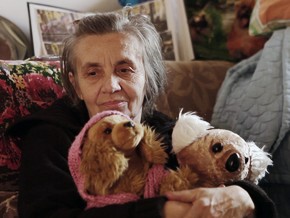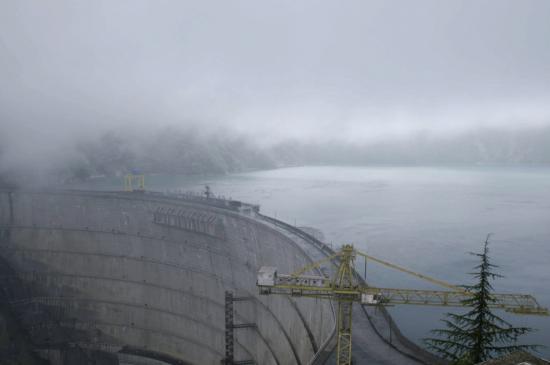“Father” earns Golden Dove in International Competition at DOK Leipzig
Golden Dove in the German Competition for “A Sound of My Own” | Audience jury awards “Dida” a Golden Dove
The award-winning films of the 64th edition of DOK Leipzig have been chosen. The gala award ceremony for the Golden and Silver Doves was held on Saturday evening before a live audience at Leipzig’s CineStar.
The Chinese documentary “Father” by Wei Deng has won the Golden Dove in the International Competition Long Documentary and Animated Film. The director’s first feature film is a portrait of generations about his father and grandfather that depicts tradition and change, violence and alienation in Chinese society. “Sincere, poignant and haunting – the narrative goes beyond what is visible to the eye. It shows the complexity of life and becomes a pure homage to humanity,” the jury’s statement reads. The Golden Dove, which includes 10,000 euros, has been sponsored by Mitteldeutscher Rundfunk since 2013. The award was presented by Dr Ulrich Brochhagen, head of MDR’s department of history, documentaries and eastern Europe. The film that earns the Golden Dove in the International Competition Long Documentary and Animated Film qualifies for nomination for the annual ACADEMY AWARDS®, provided it meets the Academy’s standards.
The Silver Dove for the best long documentary or animated film by an emerging director in the International Competition went to Karol Pałka for his first feature-length film, “Bucolic”. This Polish documentary observes a mother and her daughter in their secluded life in the countryside. The jury was impressed by the director’s “fresh and innovative cinematic approach” and highlighted the “sensitive depiction of characters” in the film. “It moves effortlessly around a magical universe with the utmost delicacy and modesty,” said the jury. The 6,000-euro award was sponsored by 3sat.
The winning long documentaries in the International Competition were selected by Grit Lemke, Anocha Suwichakornpong, Alex Szalat, Katarína Tomková and Raed Yassin. Honourable mentions by the jury went to the documentary “Republic of Silence” by Diana El Jeiroudi as well as to Sarah Noa Bozenhardt and Daniel Abate Tilahun for “among us women”.
In the German Competition Long Documentary and Animated Film, “A Sound of My Own” by Rebecca Zehr was awarded the Golden Dove. This
documentary accompanies musician Marja Burchard, who followed in her father’s footsteps and became the bandleader of the legendary Krautrock collective Embryo. She carries on her father’s tradition while seeking her own musical path in a male-dominated industry. “Different materialities and fragments lightly and playfully come together in a composition in which the montage is aware of the specific temporality of cinema,” say jury members Carsten Möller, Gudrun Sommer and Maria Speth. “On the visual as well as the sound level, this extraordinary portrait of an artist is convincing in the way the art of music and the art of documentary film meet.” The 10,000-euro award was sponsored in part by Weltkino Filmverleih GmbH. David Forcht form Weltkino Filmverleih presented the Golden Dove to the filmmaker at the award ceremony.
The Golden Dove in the Competition for the Audience Award Long Documentary and Animated Film, which includes 3,000 euros, was awarded by the audience jury to Nikola Ilić and Corina Schwingruber Ilić for “Dida”. At the centre of the film is the filmmaker’s mother, Dida, who, due to a learning disability, has always been dependent on her mother, but longs for independence. A look at a family in transition. “The film raises various questions: Who is the child, who the adult? How can one live autonomously, how can one take responsibility for a person in need of help? But above all, the film radiates warmth, humour and great joy,” the jury’s statement reads.
In the International Competition Short Documentary and Animated Film, Gugi Gumilang, Marina Koul and Izabela Plucińska chose the recipients of the Golden Doves, each endowed with 3,000 euros. The award for best documentary film went to “Abyssal” by Alejandro Alonso, the documentary observation of a ship scrapyard in western Cuba. The award for best animated film went to Marta Pajek for “Impossible Figures and Other Stories I”, a complex exploration of transience, life and death. These winning films also qualify for nomination for the annual ACADEMY AWARDS®, provided they meet the Academy’s standards. The Indonesian production “Tellurian Drama” by Riar Rizaldi received an honourable mention.
The Silver Dove in the German Competition Short Documentary and Animated Film, which includes 1,500 euros in prize money, went to Tang Han for her documentary “Pink Mao”, an analysis of the 100-yuan note, the largest denomination of Renminbi banknotes in the People’s Republic of China. Honourable mention went to “Happytrail” by Jakob Werner, Thea Sparmeier and Pauline Cremer, an animated short film about female body hair.
The Silver Dove in the Competition for the Audience Award Short Documentary and Animated Film was awarded to Diana Cam Van Nguyen for her animated film “Love, Dad”, in which a young woman comes across a letter her father had written from prison 15 years prior. The award, which includes 1,500 euros, was sponsored by the Leipziger Gesellschaft zur Förderung der Filmkunst e.V. Deputy Chairman Jens Kesseler presented the Silver Dove to the filmmaker.
Partnership Awards for documentary and animated films in competition
On Saturday afternoon, numerous partner awards were already being presented at the Regina Palast.
The DEFA Sponsoring Prize, which includes 4,000 euros granted by the DEFA Foundation, went to “Nasim” by Ole Jacobs and Arne Büttner, a portrait of an Afghan woman and her family in the Moria refugee camp on the Greek island of Lesbos. Jakob Krese and Danilo do Carmo received an honourable mention for “What Remains on the Way”.
The ver.di Prize for Solidarity, Humanity and Fairness, which includes 2,500 euros, was also awarded to “Nasim”.
The 3,000-euro MDR Film Prize for an outstanding eastern European documentary film was awarded to the Polish production “The Balcony Movie” by Paweł Łoziński, who, for two years, set up a camera on his balcony and struck up conversations with the passers-by.
The Film Prize Leipziger Ring honours a documentary film about human rights, democracy or civil engagement, is granted by Stiftung Friedliche Revolution (Foundation of the Peaceful Revolution) and comes with 2,500 euros in prize money. This year’s award went to Rami Farah and Signe Byrge Sørensen for “Our Memory Belongs to Us”, in which Syrian activists now in Paris use video clips to recapitulate their experiences fighting in the Syrian civil war.
The Goethe-Institut Documentary Film Prize was awarded to the documentary film “Republic of Silence” by Diana El Jeiroudi, whose complex montage encompasses the disintegration of Syria and life in exile in Germany. The award comes with 2,000 euros in prize money, licensing, and subtitling in eight languages.
The 2,000-euro Young Eyes Film Award, granted by Leipziger Stadtbau AG, went to Johanna Seggelke for her coming-of-age story “Reality Must Be Addressed”. The prize was awarded by the Youth Jury in cooperation with Filmschule Leipzig e.V.
The 1,750-euro Prize of the Interreligious Jury was awarded to Cléo Cohen for her film “May God Be with You”, an attempt to reconcile her Arab and Jewish selves by posing questions to her grandparents. The award is granted by the Interreligiöser Runder Tisch Leipzig, the Oratorium zu Leipzig and VCH-Hotels Deutschland GmbH – im Verband Christlicher Hoteliers e.V., including Hotel MICHAELIS Leipzig.
The Prize of the International Film Critics (FIPRESCI Prize) has gone to “Words of Negroes”. In this film, Sylvaine Dampierre has the workers of an old sugar refinery read passages from the transcripts of an 1842 court case, in which slaves testified against their violent master.
The mephisto 97.6 Award went to Mahboobeh Kalaee for the animated Iranian film “The Fourth Wall”, in which a stuttering boy transforms an Iranian kitchen into a fantastic cosmos.
The Gedanken-Aufschluss Prize went to “The Crossing” by Florence Miailhe. The prize was awarded by a jury of prisoners of the Juvenile Detention Centre Regis-Breitingen.
Awards presented as part of DOK Industry
As part of the industry platform DOK Industry, five awards were presented during the festival week.
Awarded in the DOK Co-Pro Market:
Culture and Tourism Division of the Saxon State Ministry for Science, Culture and Tourism (along with 5,000 euros): “Broken Flower” by Sarvnaz Alambeigi (Iran)
The prize is donated by: State Ministry for Higher Education, Research and the Arts
Current Time TV Award (along with 1,500 euros): “Cadillac Dreams” by Elene Mikaberidze (Georgia, France)
The prize is donated by: Current Time TV
The EWA Diverse Voices Award (along with 1,000 euros and a year-long mentorship by DOK Leipzig): “The Woman Who Poked the Leopard” by Patience Nitumwesiga (Uganda)
The prize is donated by: EWA – European Women’s Audiovisual Network
Presented at DOK Preview Germany:
D-Facto Motion Works-in-Progress Prize (post-production grant of 10,000 euros): “President’s Tailor – From Auschwitz to the White House” by Rick Minnich (Germany, USA)
The prize is donated by: D-Facto Motion GmbH
Presented for the first time at DOK Short n’ Sweet:
Square Eyes Festival Consultation Award (along with a festival strategy consultation by Square Eyes): “Me & Her” by Eldar Basmanov & Ahmed Fouad Ragab (Estonia, Russia, Egypt)
The prize is donated by: Square Eyes
A total of around 170 films and extended reality works were shown in the Leipzig venues during the week of the festival.
After the festival, a selection of the films can also be viewed online throughout Germany in the DOK Stream from 1 to 14 November 2021, including all of the films that have received a Golden or Silver Dove.
https://www.dok-leipzig.de/




